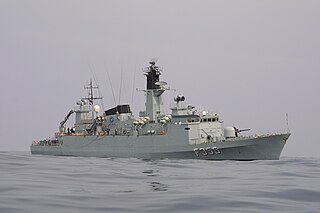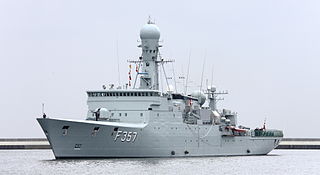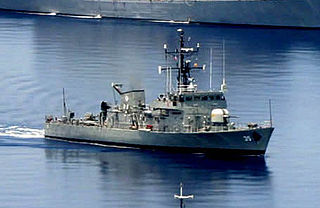
The Flyvefisken-class patrol vessels are warships of the Royal Danish Navy. The class is also known as the Standard Flex 300 or SF300 class. The five vessels sold to the Portuguese Navy are locally referred as Tejo class.

The Kingston class consists of 12 coastal defence vessels operated by the Royal Canadian Navy. The class is the name for the Maritime Coastal Defence Vessel Project (MCDV). These multi-role vessels were built and launched from the mid- to late-1990s and are crewed by a combination of Naval Reserve and Regular Force personnel. The main mission of the vessels is to train reservists, coastal patrol, minesweeping, law enforcement, pollution surveillance and search and rescue duties. The multi-purpose nature of the vessels led to their mixed construction between commercial and naval standards. The Kingston class is split between the east and west coasts of Canada and regularly deploy overseas to West Africa, Europe, Central America and the Caribbean.

The SIGMA class is a Dutch-built family of modular naval vessels, of either corvette or frigate size, designed by Damen Group.

HDMS Olfert Fischer (F355) was a Niels Juel-class corvette of the Kongelige Danske Marine. The vessel was laid down in December 1978 and commissioned in October 1981. The corvette operated in the Persian Gulf on two occasions, first in 1990 and 1991 as part of the multinational fleet enforcing the United Nations sanctions against Iraq, then again in 2003 in support of the United States-led invasion of Iraq. Olfert Fischer was deployed as part of the NATO Standing Naval Force Atlantic on at least four occasions during her career.

The Niels Juel class was a three-ship class of corvettes formerly in service with the Royal Danish Navy. They were built in Denmark at Aalborg Shipyard and were launched in the period 1978–1980. In 1998–2000 the three vessels had a mid-life update, as well as a large update on the electrical systems.

The Thetis-class ocean patrol vessels or ocean patrol frigates, also called Stanflex 3000, is a class of large patrol vessels built for the Royal Danish Navy. The class comprises four ships, all built and commissioned in the early 1990s. The ships' tasks are mainly maintenance of sovereignty, search and rescue, fishery inspection and support to local authorities. The operation areas are normally Greenland and the Faroe Islands, but the vessels also operate near Iceland on transit between Greenland and the Faroe Islands, and near Denmark.

The Absalon class are frigates of the Royal Danish Navy, commissioned in 2005. The two ships in the class may be described as a hybrid between a frigate and military transport ship with multiple role capabilities, with the capacity to be transformed from a combat ship with the firepower of a traditional frigate to a hospital ship within a day.

The BRP Emilio Jacinto (PS-35) is the lead ship of the Jacinto-class corvettes currently assigned to the Offshore Combat Force of the Philippine Fleet. She is one of few ships in the Philippine Navy equipped with modern systems after the completion of combat, navigation and weapon systems upgrade of her class in August 2019. She was originally called HMS Peacock (P239) during her service with the Royal Navy.

The BRP Apolinario Mabini (PS-36) is the second ship of the Jacinto-class corvettes currently assigned to the Offshore Combat Force of the Philippine Fleet. She is one of few ships in the Philippine Navy equipped with modern systems after the completion of combat, navigation and weapon systems upgrade of her class in August 2019. She is named after Apolinario Mabini, a hero of the Philippine revolution and a former prime minister. She was originally called HMS Plover (P240) during her service with the Royal Navy.

The Iver Huitfeldt class is a three-ship class of air defence frigates that entered service with the Royal Danish Navy in 2012 and 2013.

The Knud Rasmussen class is a class of offshore patrol vessels operating in the Royal Danish Navy from 2008. Built to replace the Agdlek-class cutters on a one-for-one basis, the Knud Rasmussen-class vessels are significantly larger, enabling patrols further offshore.

The Double Eagle is a remotely operated vehicle (ROV) built by the Swedish defence company Saab Underwater Systems AB and used for the disposal of naval mines.

The Arafura class is a class of offshore patrol vessels being built for the Royal Australian Navy (RAN). Initially proposed in the 2009 Defence White Paper and marked as procurement project SEA 1180, it was originally planned that 20 Offshore Combatant Vessels (OCV) would replace 26 vessels across four separate ship classes: the Armidale-class patrol boats, the Huon-class minehunters, the Leeuwin-class survey vessels, and the Paluma-class survey motor launches. Although having a common design, the ships would use a modular mission payload system to fulfill specific roles; primarily border patrol, mine warfare, and hydrographic survey. The 2013 Defence White Paper committed to the OCV project as a long-term goal, but opted in the short term for an accelerated procurement of an existing design to replace the Armidales, and life-extension refits for the other types. This resulted in the Offshore Patrol Vessel (OPV) project and the amount of vessels reduced to 12. However, this was further increased to 14 when 2 further Mine Counter Measures variants were proposed under SEA 1905.

The Fleet-class unmanned surface vessel, also called the Common Unmanned Surface Vessel (CUSV) and later the Mine Countermeasures Unmanned Surface Vehicle, is an unmanned surface vessel designed for the United States Navy to be deployed from Freedom and Independence-class littoral combat ships and intended to conduct mine and anti-submarine warfare missions. As of 2012 four units of the class have been built; the first was delivered to the U.S. Navy in 2008.

HDMS Diana is the first of six vessels in the Diana-class built to patrol in the Danish territorial waters. The ship is named after the Roman goddess of the hunt. Diana, like all her sister ships, was built in Faaborg yard.

The Diana class, also known as the Minor Standard Craft Mk II, are a class of six patrol boats in service with the Royal Danish Navy. Built by Faaborg Værft A/S, the ships displace 280 tonnes and have a maximum speed of 18 knots knots. The class was intended to replace the aging Barsø class of patrol boats. The lead ship of the class, HDMS Diana, entered Danish service in 2007. The Diana-class vessels were initially tasked with fisheries protection, patrol and search and rescue but are currently tasked with international and combat operations.

HDMS Iver Huitfeldt (F361) is a Iver Huitfeldt-class frigate in the Royal Danish Navy. The ship is named after Iver Huitfeildt, a 17th-century Danish officer.

HDMS Peter Willemoes (F362) is a Iver Huitfeldt-class frigate in the Royal Danish Navy. The ship is named after Peter Willemoes, a 18-19th-century Danish officer.

HDMS Niels Juel (F363) is an Iver Huitfeldt-class frigate in the Royal Danish Navy. The ship is named after Niels Juel, a 17th-century Danish admiral.



















